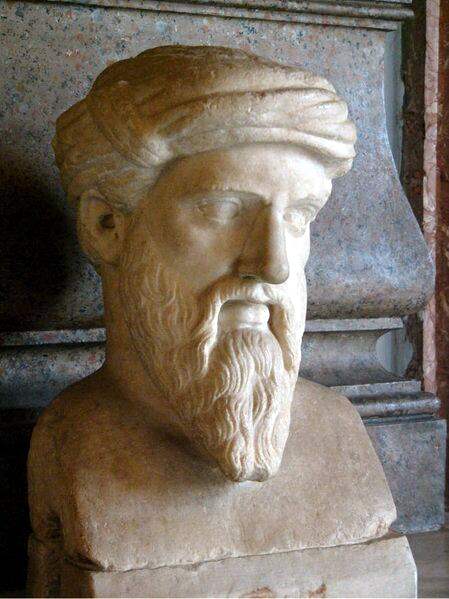Oddly, one place where Pythagoras’ name is currently invoked is in the world of baseball, in the form of “Pythagorean expectations” (the original term as coined by Bill James) or, more commonly, “Pythagorean wins.” If you remember your high school geometry class, you’ll recall that the Pythagorean theorem runs as follows: a2+b2=c2, where a is the right angle side of the triangle, b is the base & c is the hypotenuse (the other side!) Bill James created a similar formula to determine how many wins a team would be expected to achieve based on the number of runs they scored & allowed. In James’ original formula, Pythagorean expectation is described as follows:
Now we turn our gaze to this very baseball season, & to the city of Baltimore, Maryland, home of the Orioles baseball team. As of this writing, the Orioles are tied for first place with the New York Yankees for first-place in the American League East Division; worth noting here that 1. the American League East is typically considered baseball’s strongest division, & 2. the Yankees are considered one of the top two or three teams in the Majors this year, & were a favorite to win the division from the onset. If the Yankees were to have been challenged for the division, conventional wisdom this spring ran, it would be by their long-time rivals, the Boston Red Sox & perhaps the always tough Tampa Bay Rays. The Orioles were seen as a cellar team, lagging behind the Toronto Blue Jays.
.jpg) |
| Adam Jones looks to the heavens |
But the Red Sox, as they have a wont to do at regular intervals throughout their existence, found all sorts of intriguing—if hideous—ways to implode & jettison their season, & Toronto suffered a staggering number of injuries both to their starting pitching staff & to key players. Tampa has performed well thru the season overall, tho they are held back by a somewhat weak offense, & also lost their slugging third baseman Evan Longoria for a good portion of the year. Now Longoria is back in the line-up, & that seems to have given them a bit of a boost, tho it’s clear that he’s still suffering effects from the injury.
 |
| CC Sabathia, who has been injured off & on in 2012 |
& then there were the Orioles. They’ve spent the season occupying one of the top three spots in the division standings—they even led at one point in the spring before the Yankees caught them; after all, there’s often a surprise team in the first month or two that is ultimately humbled by the real powers. But Baltimore, as they say in baseball, “refused to go away.” Despite being scoffed at by most baseball pundits, who opined bluntly that the Orioles are not “for real,” they stayed within striking distance of the division lead, & also maintained their position as one of the top candidates for the wild card spots. & as of yesterday, 9/4/12, when the Yankees lost to Tampa & the Orioles defeated Toronto, Baltimore & New York found themselves in a tie for first.
The Yankees are a team filled with stars, but stars who are old in baseball years—as a result, they’ve suffered a number of key injuries down the stretch. Some commentators recently have said, well yes, the Orioles took 2 out of 3 from the Yankees this past weekend, & yes, they’re in a dead heat, but this is not the “real” Yankees, & the Orioles will soon see their magic coach become a pumpkin again.
 |
| Pythagoras: detail from Raphael's "School of Athens": on paper |
The reasoning, beyond simple line-up comparisons (& yes, the Yankees do look like the far better team “on paper”), has to do with run differential, which if you followed the Pythagorean expectation formula above, is obviously key to that method of calculating “expected” or it might be said “ideal” (in the philosophical sense) wins. The Yankees have outscored their opponents by 83 runs, the second best total in the American League (trailing only Texas at 118); Tampa is close, with an +81 differential, & they do only trail the Yankees & Orioles by 1-1/2 games. The Orioles, meanwhile, have surrendered 19 more runs than they have scored, & still are tying the Yankees with a record of 76-59. By point of comparison, the Red Sox have been outscored on the season by 8 runs, & their won-lost record stands at 63-74, a full 14 games out of first; the team with the closest run differential to the Orioles (admittedly, in the National League) is the Philadelphia Phillies, who have been outscored by 21 runs, have a 65-71 record & are 18-1/2 games out of first place in the National League East!
 |
| Zach Britton |
There are essentially four weeks remaining in the season, & there’s a good chance that at least a couple of teams who are currently in the playoff picture will fade by the beginning of October. Certainly the Orioles could be one of those teams, & if one were a gambler (which I’m not), that would probably be the smart bet.
 |
| Epicurus |
For myself, I’ll follow the story with interest—it’s these very narratives that make the epic baseball season so compelling. Of course, tho I’ve long given my allegiance to the San Francisco Giants & the National League, I still have enough vestigial Red Sox fan in me from my youth to get delight on those rare occasions when the Yankees fall—tho interestingly, when I was in grade school & high school, the Orioles were the dominant team always ahead of the Sox—I was too young to really be cognizant of the early 1960s Yankees powerhouses featuring Mantle, Maris, Ford et al. I remember the Orioles of Frank & Brooks Robinson, Jim Palmer, Mike Cuellar, Boog Powell, Paul Blair & more—incredibly strong teams.
Soon enough, October 3rd will be upon us, & if we don’t know how the regular season portion of the 2012 baseball epic ends that morning, we certainly should by that night. Until then—probability & the ideal aside—days will pass, plays will be made, pitches thrown, balls hit, & games will be won & lost.
 |
| Orioles Park at Camden Yards: Cave of Shadows or Seat of Being? |
All images link to their source
- Bust of Pythagoras of Samos in the Capitoline Museums, Rome: Wiki Commons: by Galilea, who publishes it under the Creative Commons Attribution-Share Alike 3.0 Unported license.
- Pythagorean expectation formula: Wikipedia page on the subject.
- Adam Jones popping one up: Wiki Commons, by user Keith Allison, who publishes it under the Creative Commons Attribution-Share Alike 2.0 Generic license.
- C.C. Sabathia [Yankees star pitcher]: Wiki Commons by chris.ptacek, who publishes it under the Creative Commons Attribution 2.0 Generic license.
- Detail from Raphael's "The School of Athens": Wiki Commons, public domain
- Zach Britton Wiki Commons, by user Keith Allison, who publishes it under the Creative Commons Attribution-Share Alike 2.0 Generic license.
- Epicurus, ancient Greek philosopher. From Thomas Stanley, (1655), The history of philosophy: Wiki Commons, public domain
- Oriole Park at Camden Yards: Wiki Commons by Kevin Farner, who publishes it under the Creative Commons Attribution 2.0 Generic license

No comments:
Post a Comment
Comments are moderated, so please play nice!